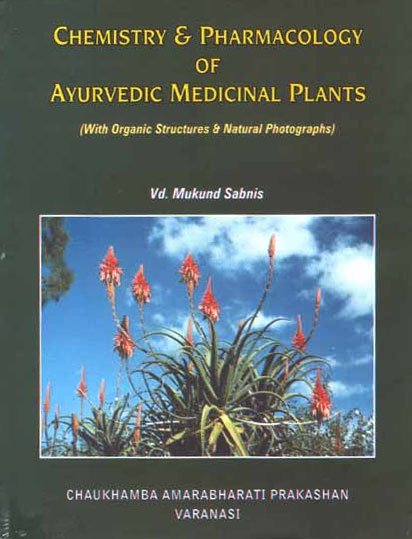Chemistry and Pharmacology of Ayurvedic Medicinal Plants
author: Mukund Sabnis
edition: 2006, Chaukhambha Amarbharati Prakashan
pages: 501
language: English
Topic: Ayurveda
Summary: This book details the Chemical and Pharmacological properties of certain plants common to Ayurveda: ancient India’s science of herbal healthcare. It is a blend between ancient Sanskrit literary botanical documentation and modern scientific purposes.
Buy now with free shipping!
Source: exoticindiaart.com
Introduction:
ASIN: B0042LY2OIAyurveda, an Indian medical science of life is gaining much popularity in India as well as in abroad. It is necessary to explore this science on the lines of modern technology for its more acceptability and popularity, Majority of the modern clinicians are not aware about these medicinal plants, though a keen interest is developing among these physicians about this ancient science. As Ayurveda is elaborated in Sanskrit and it has its own fundamentals, which are described in Ayurvedic terminologies, the modern medical and paramedical pupils are not able to understand the basic concepts of this science. As a result, many a times medicines prescribed by an Ayurvedic clinicians are ignored by the modern clinician.
The basic concepts of Ayurveda and the medicines used in this system gives excellent results if used in proper manner With the help of modem technology much of the research work is undergoing related with this science to explore the benefits of the medicines. This work is proving to be helpful in giving better results to the mankind to ameliorate the life style of modern civilized peoples.
After much efforts we have brought up this work for the modern scientist working in the field like medicine, pharmacology and biochemistry in such a manner that it may become easy to understand this science in their own language. This will help in the development and propagation of Ayurveda through inter disciplinary approach. The book elaborates the contraindication, drug interactions, metabolism of many of the herbs with their detail chemical constitution and pharmacology. This will definitely clear the myths about this ancient science from the mind of modern clinicians and scientist. This book will also be useful to all medical practitioners in their day-to-day practice.
Available pages:
Contents of this online book (index):
The full text of the Chemistry and Pharmacology of Ayurvedic Medicinal Plants in English can be quickly summarized in the following table of contents. Becaue these pages are not available to read online, I would recommend you buy the book.
Chapter 2: Panchamahabhut and Tridosha Theory [link]
Chapter 3: Concept of Pharmacology in Ayurveda [link]
Chapter 4: Basic Principles of Bhaishajya Kalpana (Ayurvedic Pharmaceutics) [link]
Chapter 5: Introduction to Phyto Chemicals in Ayurvedic Medicine [link]
Chapter 6: Concept of Free Radical in Ayurveda [link]
Chapter 7: Concept of Immunity In Ayurveda [link]
Chapter 1: Chemistry and Pharmacology of Achyranthes aspera [link]
Chapter 2: Chemistry and Pharmacology of Acorus calamus [link]
Chapter 3: Chemistry and Pharmacology of Adhatoda vasica [link]
Chapter 4: Chemistry and Pharmacology of Aegle marmelos [link]
Chapter 5: Chemistry and Pharmacology of Albizia lebbeck [link]
Chapter 6: Chemistry and Pharmacology of Allium sativum [link]
Chapter 7: Chemistry and Pharmacology of Aloe vera [link]
Chapter 8: Chemistry and Pharmacology of Andrographis paniculata [link]
Chapter 9: Chemistry and Pharmacology of Asparagus racemosus [link]
Chapter 10: Chemistry and Pharmacology of Azadirachta indica [link]
Chapter 11: Chemistry and Pharmacology of Bacopa monnieri [link]
Chapter 12: Chemistry and Pharmacology of Berberis aristata [link]
Chapter 13: Chemistry and Pharmacology of Boerhaavia diffusa [link]
Chapter 14: Chemistry and Pharmacology of Boswellia serrata [link]
Chapter 15: Chemistry and Pharmacology of Celastrus Paniculatus [link]
Chapter 16: Chemistry and Pharmacology of Centella asiatica [link]
Chapter 17: Chemistry and Pharmacology of Commiphora mukul [link]
Chapter 18: Chemistry and Pharmacology of Crocus sativus [link]
Chapter 19: Chemistry and Pharmacology of Curcuma longa [link]
Chapter 20: Chemistry and Pharmacology of Cyperus rotundus [link]
Chapter 21: Chemistry and Pharmacology of Emblica officinalis [link]
Chapter 22: Chemistry and Pharmacology of Glycyrrhiza glabra [link]
Chapter 23: Chemistry and Pharmacology of Gyrnnema sylvestre [link]
Chapter 24: Chemistry and Pharmacology of Hemidesmus indicus [link]
Chapter 25: Chemistry and Pharmacology of Holarrhena antidysentrica [link]
Chapter 26: Chemistry and Pharmacology of Inula racemosa [link]
Chapter 27: Chemistry and Pharmacology of Momordica charantia [link]
Chapter 28: Chemistry and Pharmacology of Moringa oleifera. [link]
Chapter 29: Chemistry and Pharmacology of Mucuna pruriens [link]
Chapter 30: Chemistry and Pharmacology of Myristica fragrans. [link]
Chapter 31: Chemistry and Pharmacology of Nardostachys jatamansi [link]
Chapter 32: Chemistry and Pharmacology of Nelumbo nucifera [link]
Chapter 33: Chemistry and Pharmacology of Nigella sativa [link]
Chapter 34: Chemistry and Pharmacology of Ocimum sanctum [link]
Chapter 35: Chemistry and Pharmacology of Phyllanthus amarus [link]
Chapter 36: Chemistry and Pharmacology of Picrorhiza kurroa [link]
Chapter 37: Chemistry and Pharmacology of Piper longum [link]
Chapter 38: Chemistry and Pharmacology of Piper nigrum [link]
Chapter 39: Chemistry and Pharmacology of Psoralea corylifolia [link]
Chapter 40: Chemistry and Pharmacology of Rauvolfia serpentina [link]
Chapter 41: Chemistry and Pharmacology of Rheum emodi [link]
Chapter 42: Chemistry and Pharmacology of Rubia cordifolia [link]
Chapter 43: Chemistry and Pharmacology of Saraca asoca [link]
Chapter 44: Chemistry and Pharmacology of Swertia chirayita [link]
Chapter 45: Chemistry and Pharmacology of Syzygium cumini [link]
Chapter 46: Chemistry and Pharmacology of Tephrosia purpurea [link]
Chapter 47: Chemistry and Pharmacology of Terminalia arjuna [link]
Chapter 48: Chemistry and Pharmacology of Tinospora cordifolia [link]
Chapter 49: Chemistry and Pharmacology of Tribulus terrestris [link]
Chapter 50: Chemistry and Pharmacology of Trigonella foenum [link]
Chapter 51: Chemistry and Pharmacology of Tylophora indica [link]
Chapter 52: Chemistry and Pharmacology of Vitex negundo [link]
Chapter 53: Chemistry and Pharmacology of Vitis vinifera [link]
Chapter 54: Chemistry and Pharmacology of Withania somnifera [link]
Chapter 55: Chemistry and Pharmacology of Zingiber officinale [link]
Chapter 1: Introduction To Toxicology in Ayurveda [link]
Chapter 2: Abrus precatorius. [link]
Chapter 3: Aconitum ferox [link]
Chapter 4: Cannabis sativa [link]
Chapter 5: Croton tiglium [link]
Chapter 6: Datura metal [link]
Chapter 7: Papaver sornniferum [link]
Chapter 8: Ricinus Communis [link]
Chapter 9: Strychnous nux vomica [link]
